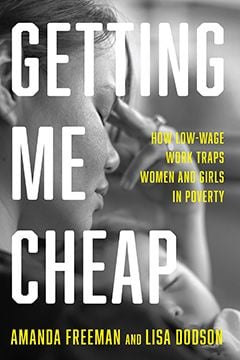In this excerpt from “Getting Me Cheap: How Low-Wage Work Traps Women and Girls in Poverty,” sociologists Amanda Freeman and Lisa Dodson examine how the country’s broken childcare system leaves poor mothers struggling to find any form of childcare in order to work – let alone the high-quality, affordable childcare that they were promised.
A key part of the national plan to end welfare was, according to then-presidential candidate Bill Clinton, the promise to “empower people with the education, training and child care they need” to move up and out of poverty. Politicians promised high-quality, subsidized childcare to enable poor mothers to discover the “dignity of work,” because suddenly the work they were doing in their homes, caring for kids, no longer counted.
But the availability of childcare has never come close to meeting the need. Today, most states serve only between 5-25% of eligible families who qualify for childcare subsidies. Sheila Katz, a white professor at the University of Houston and an expert on women’s poverty and social welfare, explains: “With welfare reform, the politicians became much more interested in forcing women to work, and then kind of offering child care while they worked, but that child care was never comprehensive enough to care for their kids.”
Across the country, we heard moms complain about incredibly long wait lists, especially for spots in subsidized daycare centers. One low-income mom in Denver explains she’s only able to work five hours a day until her daughter gets off a waiting list for after-school care: “She’s on four wait lists. But I can’t leave a 7-year-old alone. I broke down this week.”

(Courtesy of The New Press)
Childcare aid for low-income families consists of means-tested or income-eligibility vouchers, Head Start and Pre-K programs. Childcare is not an entitlement program like Social Security or veterans benefits. When childcare money runs out, they start waiting lists. Only about 40% of eligible children get into Head Start and early Head Start programs, and with thousands of families on wait lists, many will never get off. Other federal aid for childcare provided through tax credits never reaches low-income families because care has to be paid for up front.
The insufficient public childcare system (or lack thereof) in the U.S. stands in contrast to European countries who invest heavily in universal programs that serve all children. Even affluent families struggle to find daycare openings, especially in major metropolitan areas where some wait lists open months before birth.
The U.S. may find a model for high-quality universal public childcare for 3- and 4-year-olds in Portland, Oregon, starting in the fall of 2022.
In 2020, Multnomah County passed a ballot measure approving a tax on the wealthy to fund a year-round childcare and preschool program for all resident children in this age bracket. Portland’s plan includes options ranging from home to center-based care in different languages and locations around the county. All kids may attend up to six hours per day free of charge; kids from low-income families receive up to 10 hours per day and priority enrollment. Different locations offer evening and weekend hours. The measure passed with wide-ranging public support, perhaps in part because of the aim to serve all children.
Portland State University economics professor Mary King, a public childcare expert and advocate, describes the public support she observed before the vote. “Parents really seemed to have an understanding that child care is not affordable for most people. So that, you know, it’s a real issue for middle-class families, as well as lower-income families, to pay for child care, despite the fact that you can’t make a decent living doing it.”
Women like Joan who serve as daycare providers, preschool teachers, and babysitters are some of the lowest paid workers in America, though they provide what moms universally recognize as the most important service. Around 95% of childcare workers are women and they are disproportionately women of color, according to the Economic Policy Institute. The median wage for childcare workers is around $10 an hour, compared to $17 for workers in other occupations. One in seven are living in poverty, and they are much less likely than other workers to have benefits at work, with 85% of childcare workers reporting they do not receive health insurance coverage from their jobs.
Universal childcare in Portland stands out partially because of the plan to increase the salaries of all childcare workers, including classroom aides and teaching assistants, to a minimum of around $20 an hour. These are not just public school employees who are a part of a union but also in-home daycare providers and aides. Programs like the one in Portland are rare, but they show the possibility of treating children as a community priority — ultimately perhaps as a national priority.
Even with incremental progress, gaps will persist. There is wide-ranging public support for proposals on the local and national level to expand public schooling to include a preschool component for 3- and 4-year-olds. But there is much less public conversation and support for expanding opportunities and assistance for infant care, which is even more expensive and harder to find than care for older kids.
According to Professor King, “The people in the campaign I was working with very much see preschool as the first and easiest step. The next thing that is absolutely necessary is zero to two [years old] … both because it’s a huge crying need and so expensive, so challenging, and because there’s the recognition that once you have a better paid universal preschool program, even fewer providers are going to offer infant and toddler care.”
In contrast to valuing childcare, mothers offered detailed accounts of problems accessing and relying on the current system of childcare “assistance.” They reported filling out mountains of paperwork to apply, certify, and recertify qualifications for a voucher. Since the amount of the voucher is adjusted by income, moms would continuously report their earnings, which caused trouble when hours fluctuated as they often did. Fran, a single mother of two young children living in public housing in Boston, says, “It’s hard to get hired when you are a parent, but I need to get a job first to get a voucher for her to go to daycare” in order to go to work.
Caught in a similar dilemma, Jesse tried to enroll her daughter in the childcare assistance program in Connecticut called Care 4 Kids but discovered she made too much. “I think it was like $16 extra a month or something over the limit, so they wouldn’t give it to me.” But after leaving that job, she also couldn’t qualify for a Care 4 Kids voucher until she had lined up another job, which was impossible without childcare arrangements.
Even after securing a childcare voucher, finding a provider who would accept the voucher was equally challenging. We met several low-income moms providing childcare services out of their homes who had difficulty enrolling kids with subsidies because of the paperwork nightmare and problems the ever-changing subsidies created for providers. Aurora, a single mom of an 8-year-old son, moved from Montana to California when she was accepted into an apprenticeship program to learn a trade. It seemed like the perfect opportunity to get her little family on its feet.

(Photo by Aaron Burden / Unsplash)
Aurora could not find any providers with openings that would take her voucher. “Why do all these places refuse to take the state money? Because they are not really about helping a single mom make it,” she says. She also speculates that the state requires too much paperwork and makes it hard for childcare providers to accept subsidies.
Voucher use also tends to be clustered in areas with lower average incomes adding to economic segregation. Some childcare providers in affluent areas are never even asked about accepting a subsidy. A study by the Urban Institute uncovered some troubling patterns among providers who accepted vouchers, including lower teacher wages, higher teacher turnover, and more students assigned to each teacher. They found that half of family daycare providers and around 60% of daycare centers had served at least one student with a voucher in the previous six months. It’s important to keep in mind, however, these rates are tracking the regulated childcare market, which doesn’t include providers working off the books. According to the same report, one reason some providers cited for accepting students with subsidies was because of the guarantee of on-time payment for at least some part of the tuition.
Holding on to a childcare voucher is also tricky and usually short-lived. Poor moms navigate a tangle of rules and regulations in order to maintain their subsidies, and they cannot be late with their portion of the payment if they want to keep their spots. Losing a childcare voucher for even a month or two could mean dropping out for a semester or getting fired from a job because of excessive absences. The moms we spoke with worked around the clock to fulfill all of the requirements on a continuous basis, usually after long hours on the job and caring for kids.
The average annual cost of daycare for an infant in the state of Massachusetts is a whopping $20,913, according to the Economic Policy Institute’s childcare calculator, straining the budgets of even middle-class parents. A minimum-wage worker would have to surrender their entire paycheck for more than 10 months of the year to cover it.
According to the Center for Law and Social Policy, families below the poverty line who pay privately for childcare typically spend an average of 30% of their income on it. The prohibitive cost of childcare forced several moms we met to compromise on the quality of care, just to ensure their kids were somewhere. Jill, a white mom from Connecticut, turned to a woman in her neighborhood who she knew through her church offered low-cast babysitting. “It was just the kind of thing you could bring your kid there for the day and it was super cheap, like $30 for the day and convenient,” she says. “She wasn’t teaching them anything, but she’s literally just watching them, feeding them, making sure they don’t die… . Of course, I’d rather have [my daughter] somewhere else, learning, going out to the pool or the park if it was the summer. I didn’t just want her stuck inside, but sometimes it wasn’t worth it because I couldn’t pay my other bills.” There is no question that factors like cost and convenience impact poor mothers’ decisions about childcare.
When her daughter turned four, Jill qualified for an income-adjusted preschool, which she and her daughter both love. “It’s a sliding scale. I only pay $120 a week, and it’s a longer, full day to five o’clock instead of three. When you first enroll, you have to show what you are making, and that’s how they set our tuition,” she explained. Jill appreciates that the teachers bundle up the kids and take them to play outside, no matter what the weather; the school is focused on learning and discipline, and it’s only five minutes from her house. “It’s the best childcare I’ve had so far, other than my parents.”
Copyright © 2022 by Amanda Freeman and Lisa Dodson. This excerpt originally appeared in “Getting Me Cheap: How Low-Wage Work Traps Women and Girls in Poverty,” published by The New Press. Reprinted here with permission.

Amanda Freeman is an assistant professor of sociology at the University of Hartford and a writer and researcher of motherhood and work. She lives in Westport, Connecticut, and Getting Me Cheap (The New Press) is her first book.

Lisa Dodson is Research Professor Emerita at Boston College. She is the author of The Moral Underground: How Ordinary Americans Subvert an Unfair Economy and co-author (with Amanda Freeman) of Getting Me Cheap: How Low Wage Work Traps Women and Girls in Poverty (both from The New Press) and Don’t Call Us Out of Name. She lives in Portland, Oregon.
















